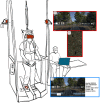Immersive Virtual Reality during Robot-Assisted Gait Training: Validation of a New Device in Stroke Rehabilitation
- PMID: 36557007
- PMCID: PMC9782023
- DOI: 10.3390/medicina58121805
Immersive Virtual Reality during Robot-Assisted Gait Training: Validation of a New Device in Stroke Rehabilitation
Abstract
Background and objective: Duration of rehabilitation and active participation are crucial for gait rehabilitation in the early stage after stroke onset. Virtual reality (VR) is an innovative tool providing engaging and playful environments that could promote intrinsic motivation and higher active participation for non-ambulatory stroke patients when combined with robot-assisted gait training (RAGT). We have developed a new, fully immersive VR application for RAGT, which can be used with a head-mounted display and wearable sensors providing real-time gait motion in the virtual environment. The aim of this study was to validate the use of this new device and assess the onset of cybersickness in healthy participants before testing the device in stroke patients. Materials and Methods: Thirty-seven healthy participants were included and performed two sessions of RAGT using a fully immersive VR device. They physically walked with the Gait Trainer for 20 min in a virtual forest environment. The occurrence of cybersickness, sense of presence, and usability of the device were assessed with three questionnaires: the Simulator Sickness Questionnaire (SSQ), the Presence Questionnaire (PQ), and the System Usability Scale (SUS). Results: All of the participants completed both sessions. Most of the participants (78.4%) had no significant adverse effects (SSQ < 5). The sense of presence in the virtual environment was particularly high (106.42 ± 9.46). Participants reported good usability of the device (86.08 ± 7.54). Conclusions: This study demonstrated the usability of our fully immersive VR device for gait rehabilitation and did not lead to cybersickness. Future studies should evaluate the same parameters and the effectiveness of this device with non-ambulatory stroke patients.
Keywords: cybersickness; gait rehabilitation; head-mounted display; robot-assisted gait training; virtual reality.
Conflict of interest statement
The authors declare no conflict of interest.
Figures


Similar articles
-
Immersive virtual reality during gait rehabilitation increases walking speed and motivation: a usability evaluation with healthy participants and patients with multiple sclerosis and stroke.J Neuroeng Rehabil. 2021 Apr 22;18(1):68. doi: 10.1186/s12984-021-00848-w. J Neuroeng Rehabil. 2021. PMID: 33888148 Free PMC article. Clinical Trial.
-
The effects of virtual reality augmented robot-assisted gait training on dual-task performance and functional measures in chronic stroke: a randomized controlled single-blind trial.Eur J Phys Rehabil Med. 2021 Apr;57(2):227-237. doi: 10.23736/S1973-9087.21.06441-8. Epub 2021 Feb 4. Eur J Phys Rehabil Med. 2021. PMID: 33541040 Clinical Trial.
-
Virtual reality to augment robot-assisted gait training in non-ambulatory patients with a subacute stroke: a pilot randomized controlled trial.Eur J Phys Rehabil Med. 2018 Jun;54(3):397-407. doi: 10.23736/S1973-9087.17.04735-9. Epub 2017 Dec 21. Eur J Phys Rehabil Med. 2018. PMID: 29265791 Clinical Trial.
-
Head-Mounted Display-Based Therapies for Adults Post-Stroke: A Systematic Review and Meta-Analysis.Sensors (Basel). 2021 Feb 5;21(4):1111. doi: 10.3390/s21041111. Sensors (Basel). 2021. PMID: 33562657 Free PMC article.
-
Virtual reality-based gait rehabilitation intervention for stroke individuals: a scoping review.J Exerc Rehabil. 2023 Apr 27;19(2):95-104. doi: 10.12965/jer.2346114.057. eCollection 2023 Apr. J Exerc Rehabil. 2023. PMID: 37163183 Free PMC article.
Cited by
-
The most used questionnaires for evaluating the usability of robots and smart wearables: A scoping review.Digit Health. 2024 Apr 9;10:20552076241237384. doi: 10.1177/20552076241237384. eCollection 2024 Jan-Dec. Digit Health. 2024. PMID: 38601185 Free PMC article.
-
Reduction of cognitive fatigue and improved performance at a VR-based driving simulator using tRNS.iScience. 2024 Jul 20;27(9):110536. doi: 10.1016/j.isci.2024.110536. eCollection 2024 Sep 20. iScience. 2024. PMID: 39314236 Free PMC article.
-
Is Social Training Delivered with a Head-Mounted Display Suitable for Patients with Hereditary Ataxia?Brain Sci. 2023 Jun 30;13(7):1017. doi: 10.3390/brainsci13071017. Brain Sci. 2023. PMID: 37508949 Free PMC article.
-
VR-Aided Ankle Rehabilitation Decision-Making Based on Convolutional Gated Recurrent Neural Network.Sensors (Basel). 2024 Oct 30;24(21):6998. doi: 10.3390/s24216998. Sensors (Basel). 2024. PMID: 39517895 Free PMC article.
References
-
- Mohan D.M., Khandoker A.H., Wasti S.A., Ismail Ibrahim Ismail Alali S., Jelinek H.F., Khalaf K. Assessment Methods of Post-stroke Gait: A Scoping Review of Technology-Driven Approaches to Gait Characterization and Analysis. Front. Neurol. 2021;12:650024. doi: 10.3389/fneur.2021.650024. - DOI - PMC - PubMed
MeSH terms
LinkOut - more resources
Full Text Sources
Medical

